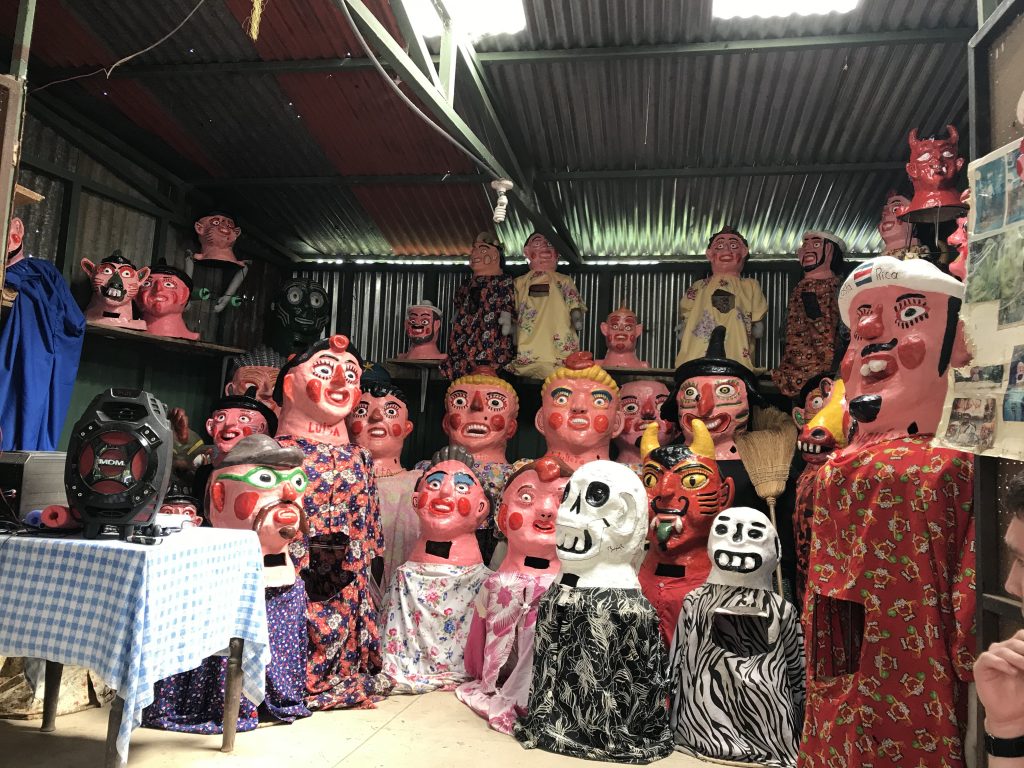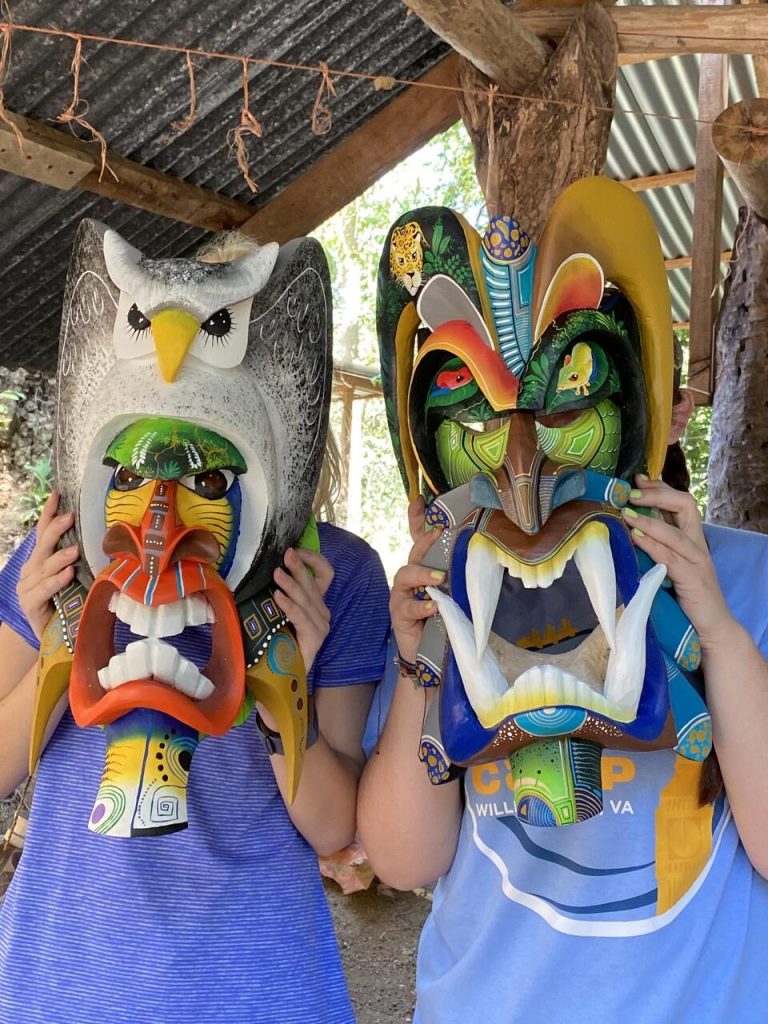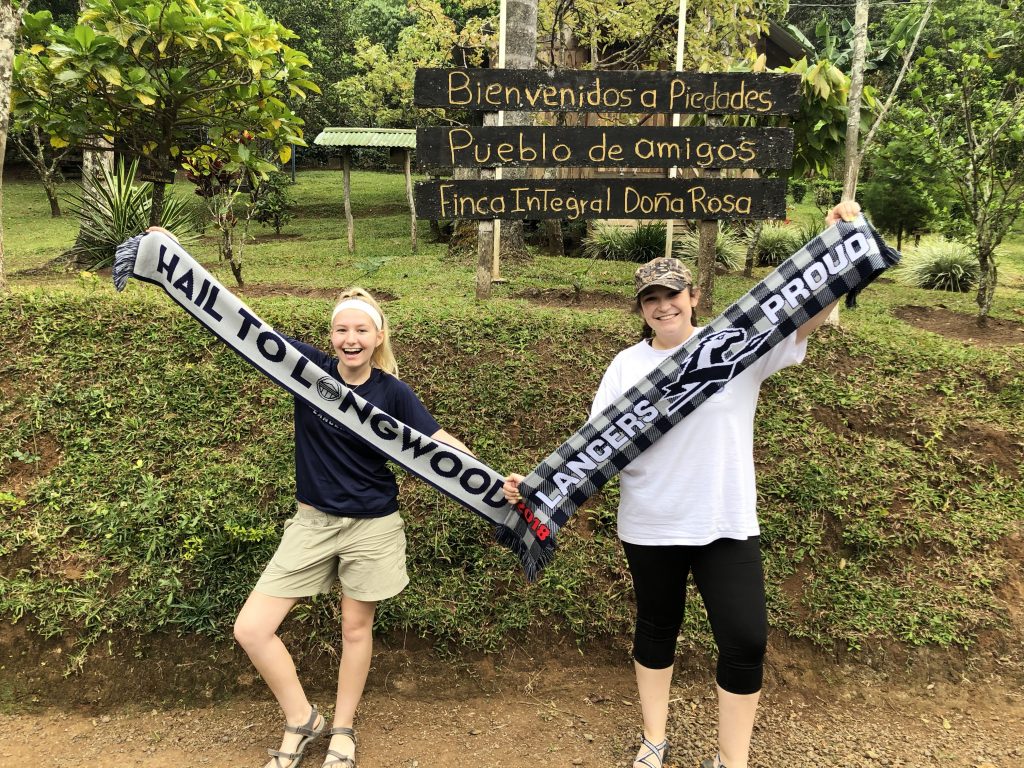For my study abroad, I was able to spend eleven amazing days in the Central American country of Costa Rica to study ecotourism. We learned about how this tiny country has been able to develop by converting almost entirely to sustainable energy sources and how it has protected its natural resources by turning them into profitable tourist areas. Every day we were doing something new and having a new experience. We visited local markets, learned dances from local students, walked through rain-forests, stayed with an indigenous tribe, and so, so much more. It was fascinating to not only be a part of a completely different culture, but to see how uniquely their economy functions as well. Overall, it was an experience I wouldn’t trade for anything as it truly was eye-opening in so many ways. ¡Pura Vida!
While we completed the majority of our coursework prior to our travels to Costa Rica, we maintained detailed journals while traveling and wrote essays about the various lessons that we learned from our experiences. Below is the final essay that I wrote detailing the potential for environmental protection and economic development to coexist based on what we had seen in Costa Rica.
Katelyn Housler
ECON 301
The Potential Coexistence of Environmental Protection and Economic Development
Some of the largest economies in the world today were built on industrialization that completely revolutionized each country. The biggest consequence to this was often mass destruction of natural ecosystems to accommodate for new infrastructure for production. In a world where climate change is increasing in prominence, it is becoming apparent that less developed countries cannot grow their economies in this same way if we hope to preserve the environment. Though this may seem like an impossible task, there are ways to successfully intertwine environmental protection and economic development so that both are productive. However, both still manage to work against each other in multiple ways.
Environmental protection and economic development seem to have one of the most symbiotic relationships in ecotourism practices. In ecotourism, businesses’ profits are tired directly to maintaining a healthy environment. Tourists come to these areas to see the scenic views and biodiversity, so it is essential that too much development does not destroy them. An economic approach to ecotourism defines it as, “Responsible travel to natural areas that conserves the environment and improves the well-being of local people” (Marks). It is all about helping a local community develop while preserving the natural environment that remains. As an industry, tourism has become exceedingly lucrative. Today, tourism represents 10.2% of the world’s gross national product, making it the primary source of income for millions of communities globally (Marks). Locals are given new opportunities for employment and entrepreneurship as the market for businesses in an area increases. Though seemingly polar opposites, there are many ways that environmental protection and economic development can coexist successfully.
One way that the government can become involved in growing the economy through environmental protection is by establishing nature reserves. As has been done in Costa Rica, governments can sell protected land to private enterprises for commercial use. Through this system, the business is required to protect the land, but can establish parks and attractions that are minimally invasive to the ecosystem. They profit by charging tourists for tickets, selling products in gift shops, providing amenities like restaurants, and engaging in many other economic activities. The privately owned Mistico Hanging Bridges preserve in Arenal is a perfect example of this. Their primary profits are generated through ticket sales, but they have also built a restaurant and gift shop where tourists can continue to spend their dollars. Though it might be a large initial investment when purchasing the land from the government and developing it, in the long-run preserves have the potential to profit significantly. Because they are profiting from tourists coming to visit, it is directly in a preserve’s best interest go invest in the land and give it room to flourish. Tourists come to parks because they want to see the land in its natural state and to observe the biodiversity of an area. Preserves who do not do enough to protect the environment will lose their competitive advantage and their business as a result. There is also a high likelihood that these businesses will have a significant impact on the local economy and drastically increase the money multiplier. For instance, they might use their proceeds to purchase products from local artists to stock their gift shops. The artists will then use their profit to buy meat from a local butcher who might need to purchase furniture from a local store for his home. In this way, the money has managed to circulate through the economy multiple times because it was spent locally. Nature preserves such as the Santa Elena cloud forest who pay locals as employees have the ability to make this same economic impact all while protecting the nature they profit from. The government also has the ability to offer incentives that can encourage businesses to develop in environmentally protected areas. Mistico, for example, operates on an eco-credits system that allows them to receive tax breaks to operate the facility (Philippe). This is done to try to offset some of the costs of purchasing the land and to encourage the owners to preserve the land as much as possible and help it regrow in others. These incentives encourage more businesses to purchase and protect Costa Rica’s land in addition to encouraging further economic development. Similarly, showcasing smaller-scale sustainability efforts, such as farming, also have the capacity to make a significant impact on an area.
Sustainable farming is slowly increasing in prominence as new benefits continue to be realized. Though established in 1994, Finca Luna Nueva farm did not start its sustainable practices until 2008 (Roy). They practice regenerative farming that allows plants to share their nutrients instead of spreading environmentally destructive agrochemicals to sustain them. But it is the growing interest in sustainable practices that is bringing farms like Finca Luna Nueva so much profit. In addition to farming, they also host tourists in lodging that is available, have a gift shop, and most importantly, provide guided tours of the estate. All of these activities give the farm an economic incentive to operate outside of their traditional agricultural production. They receive more profit than a traditional farm of the same size because they are sustainable and can bring in paying tourists. The farm Franklin showed us ran on a very similar model and is seeing some of the same success as Finca Luna Nueva. The tours and demonstrations it gives are bringing tourism to small areas like Pal Michal that depended almost entirely on agricultural historically. Profiting from the environment and protecting it instead of destroying it with mono-crop plantations is helping these smaller communities to develop. Aside from the business the environment can bring to farms, the environment can also bring businesses to a new area.
When an environmental area has an attraction like a preserve or a sustainable development farm, tourists will come to visit and businesses with inevitably follow. Tourism brings a new market to an area and locals have the opportunity to be entrepreneurs or to work for new businesses that open their doors. Monteverde is one community that has seen a significant economic impact from this. Since the environment makes attractions such as the Santa Elena Preserve, horseback riding, zip lining, and night walks possible, the town has seen a boom in economic development. Unlike other towns in the area, Monteverde has an established business district instead of the more informal porch shops and restaurants of Pal Michal. There are tourists walking around everywhere and attractions are busy with people looking for a new experience. The environmental attractions also allow businesses to profit off the environment without causing significant damage to it. Places like Xtremo Zip Lining work to show off the environment in a fun and adventurous way without causing significant deforestation or changes to the ecosystem. They profit because they have a beautiful environment to show off through their activities. The La Fortuna and Arenal area operates in much the same way. Visitors can visit the Mistico Hanging Bridges Preserve or relax in the hot springs, enjoying the environment while generating new activity in the local economy. New businesses can quickly pop up and make rapid process to help develop a relatively rural area in this way. That is how Monteverde came to be such a prominent town after Quakers from the United States came and helped develop the previous settlement (Philippe). They saw the value of the natural land and worked to turn it into the tourist destination it is today. While it is entirely possible for environmental protection and economic development to be the key to the other’s success, it is entirely too easy for them to work against each other as well.
Though ecotourism may mean the environment is being protected while helping an area to grow economically, there are many hidden negative externalities that more development can bring to an ecosystem. With an increase in ecotourism comes an increase in the number of people in environmentally sensitive areas. That means more vehicles, pollution, waste, and stress on the environment that might not otherwise be there (Marks). Bringing development into the natural world is a risk that has the potential to destroy the delicate balance within an ecosystem. Transportation accounts for 75% of Costa Rica’s energy consumption, and the vast majority of that comes from fossil fuels (Philippe). This means that higher volume of traffic and transport in an ecotourism area means greater carbon emissions which can lower the air quality in that community for humans and animals. There is also a need for infrastructure to support all of these new people coming to an area. Buildings for businesses, housing, and other needs have to be constructed and roads are needed to connect them. Additional airports may also be needed to be built, especially in lesser developed countries that may not have as many. All of this development does mean new jobs in construction and in the businesses being built, but it is harmful for nature that has been previous untouched. Development displaces the environment and there is little that can be done about it, even if it is done sustainably. Aside from this dilemma, industries that try to be more sustainable like ecotourism may struggle to be competitive with businesses that do not consider the environment as much in their decisions.
Despite all their best efforts, more sustainable forms of tourism often struggle against those that do not prioritize the environment. The more extreme forms of it are part of a niche market of people who truly care about the impact they have when going on vacation. This could be seen by comparing Pal Michal to Monteverde. In Pal Michal, the environment was constantly stressed and there were signs everywhere reminding visitors to turn off their lights and reduce water use for conservation. They incorporated the environment in to almost every part of their tourism industry, yet the community was much poorer and less developed than that of Monteverde. In Monteverde, there was significantly more economic development but much less focus on environmental preservation. Signs about saving energy and water were for the most part absent, not wanting to concern tourists with something they needed to do. The bottom line is that the majority of people go on vacation to relax and live for a few days in luxury, having new experiences. Most do not want to worry themselves with saving resources and will not go to less economically developed areas like Pal Michal even if it operates more sustainably. It is a bleak reality, but it makes it much harder for proper environmental protection to coexist with economic growth.
Though it may not always be possible, protecting the environment still has the potential to lead to economic growth when it is prioritized. Industries like ecotourism may bring negative externalities like pollution and may not always be the first choice for tourists, but they still are successful. Ecotourism is an alternative for countries to preserve their remaining ecosystems without destroying them for manufacturing or agricultural purposes. It is not a perfect solution, but it still allows for a certain level of symbiosis between economics and the environment. If economies want to be successful in the long-run, they must find ways to protect their natural resources so they are not used up completely. It is possible to profit by protecting instead of consuming.



